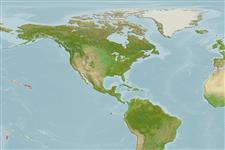Common names from other countries
>
Acropomatiformes (Oceanic basses) >
Creediidae (Sandburrowers)
Etymology: Crystallodytes: Latin, cristallum = ice + Greek, dytes = that likes to dive (Ref. 45335); cookei: Named for the malacologist Charles Montague Cooke..
More on author: Fowler.
Environment: milieu / climate zone / depth range / distribution range
Ecologia
marinhas demersal; intervalo de profundidade 0 - 15 m (Ref. 86689). Tropical
Eastern Central Pacific: Hawaii.
Tamanho / Peso / Idade
Maturity: Lm ? range ? - ? cm
Max length : 5.9 cm SL macho/indeterminado; (Ref. 40891)
Raios dorsais moles (total) : 36 - 39; Raios anais moles: 34 - 38. This species is distinguished by the following characters: D 36-39; A 34-38; pectoral rays 10-11; pelvic rays I,5; caudal-fin rays branched; scales only along the lateral line; lateral line descending gradually from the upper end of the gill opening to the lower edge of caudal peduncle, 54-57 pored scales; body depth 12.6-15.0 in SL; a series of cirri on the side of the lower lip; origin of anal fins below 4th or 5th ray of the dorsal fin; colouration - whitish to pale gray with 11-12 edged, yellow brown spots dorsally on body which appear as short triangular bars when viewed from the side, the side of the body usually has a narrow blackish stripe, radiating from eye are narrow brown bars (Ref. 86689).
Found in sand along shores exposed to wave action or in the spur and groove zone. Feeds on chironomid insects (56%), amphipods Amphilocus menehune, Cymadusa hawaiiensis, Grammaropsis atlantica, and unidentified gastropod (Ref. 86689).
Life cycle and mating behavior
Maturities | Reprodução | Spawnings | Egg(s) | Fecundities | Larvas
Randall, J.E., 2007. Reef and shore fishes of the Hawaiian Islands. Sea Grant College Program, University of Hawai'i, Honolulu. i-xivb + 1-546. (Ref. 86689)
Categoria na Lista Vermelha da IUCN (Ref. 130435)
CITES (Ref. 128078)
Not Evaluated
Ameaça para o homem
Harmless
Utilização humana
Ferramentas
Relatórios especiais
Descarregue XML
Fontes da internet
Estimates based on models
Phylogenetic diversity index (Ref.
82804): PD
50 = 0.6250 [Uniqueness, from 0.5 = low to 2.0 = high].
Bayesian length-weight: a=0.00389 (0.00180 - 0.00842), b=3.12 (2.94 - 3.30), in cm Total Length, based on all LWR estimates for this body shape (Ref.
93245).
Nível Trófico (Ref.
69278): 3.3 ±0.4 se; based on size and trophs of closest relatives
Fishing Vulnerability (Ref.
59153): Low vulnerability (10 of 100).
